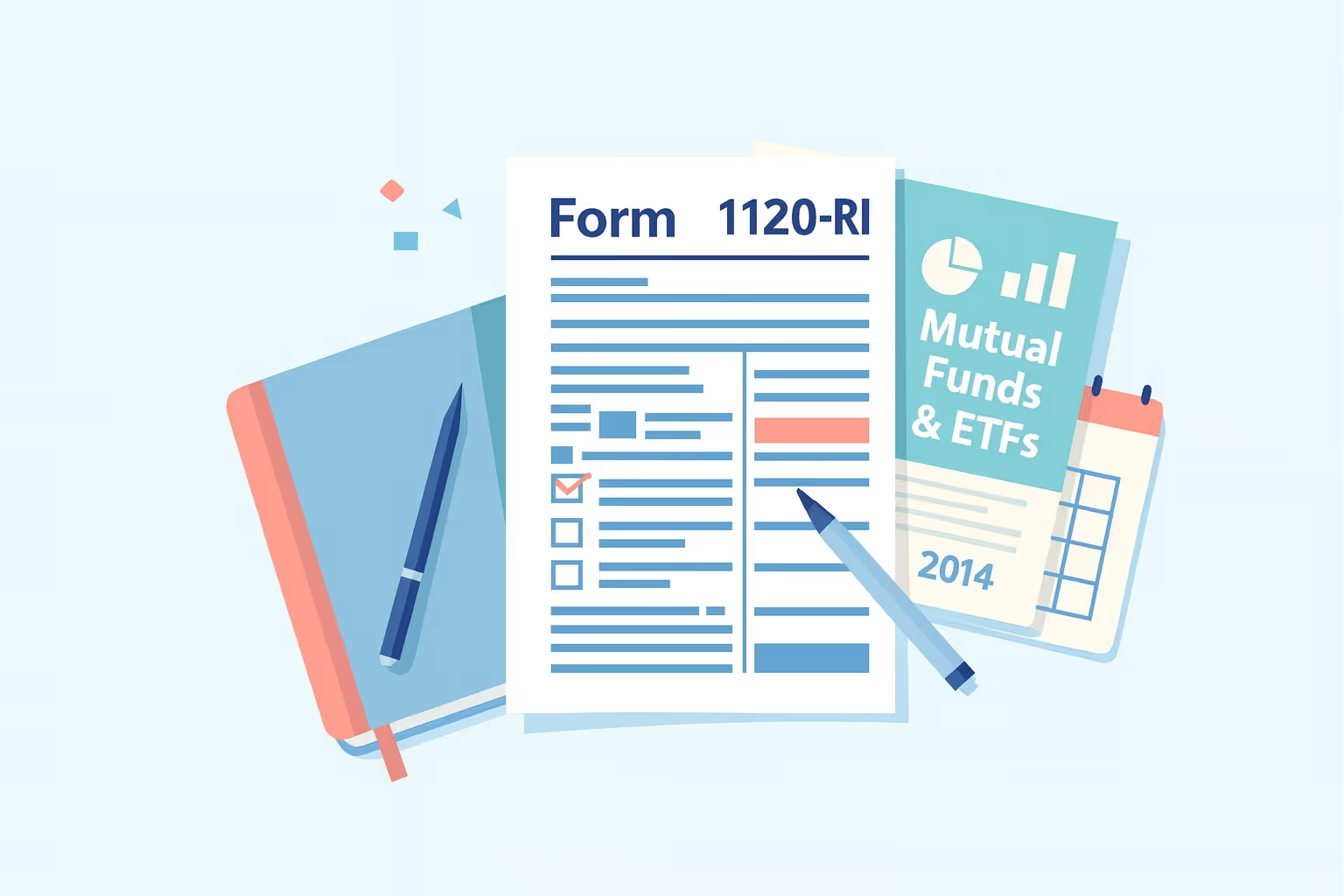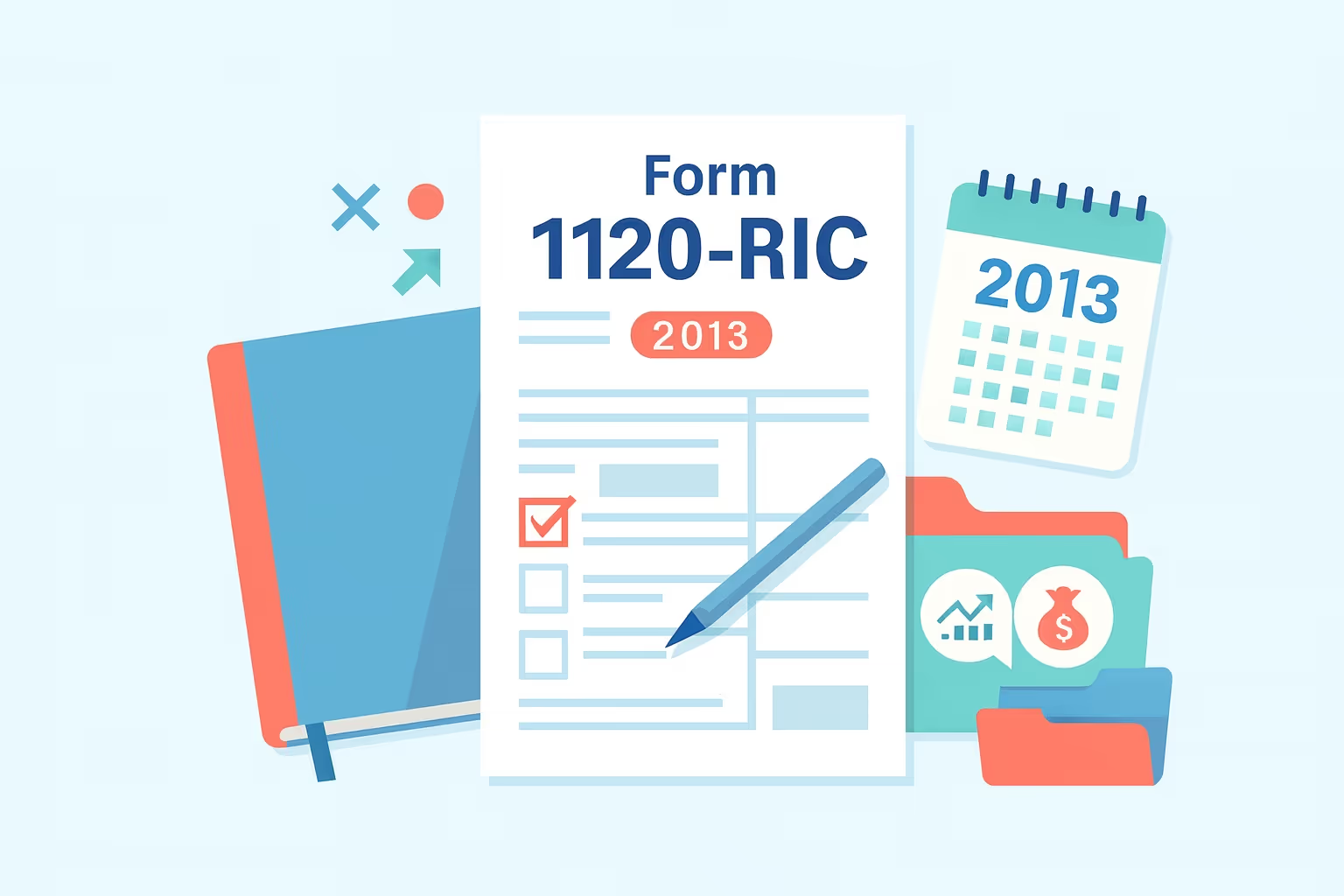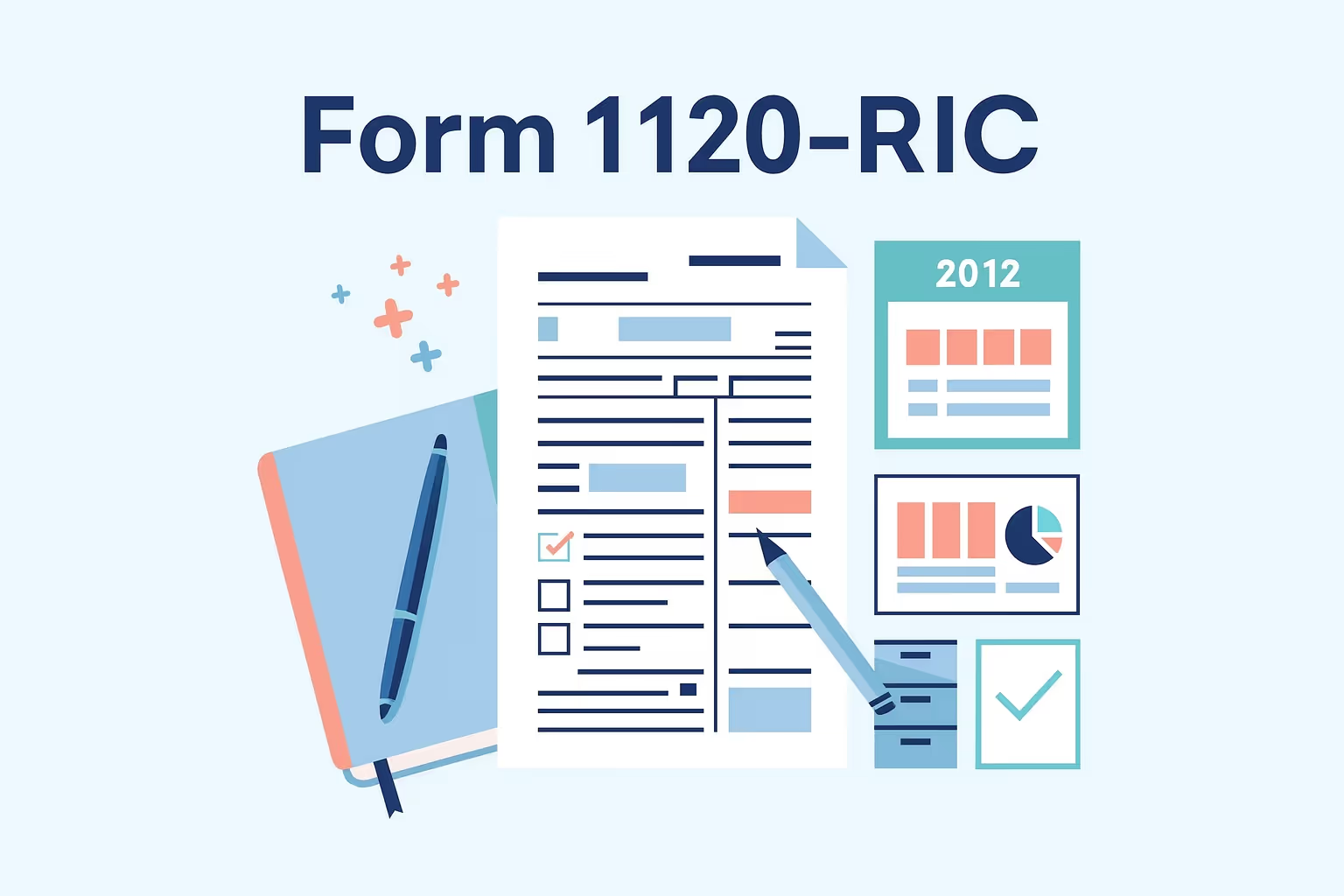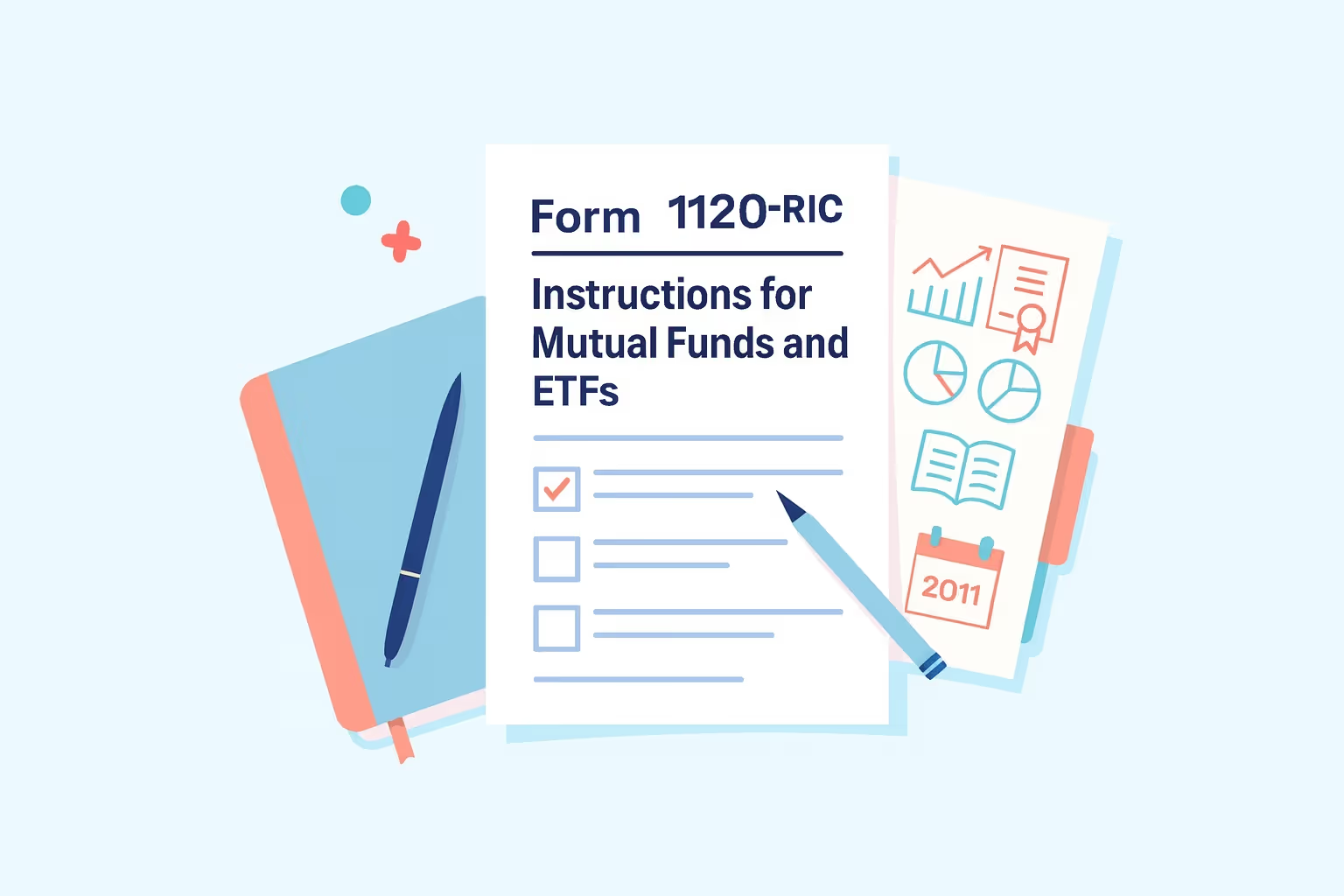Form 1120-RIC 2017 Instructions: Step-by-Step Guide
Form 1120-RIC is the federal income tax return filed by regulated investment companies such as mutual funds, exchange-traded funds, and similar investment entities. It reports income, gains, losses, deductions, and dividends paid to shareholders while determining the company’s tax liability for the year. Filing accurately ensures compliance with the Internal Revenue Service and allows investment companies to maintain their special tax treatment, which helps avoid double taxation.
For the 2017 tax year, regulated investment companies faced several updates following the enactment of the Tax Cuts and Jobs Act of 2017. These included a new flat corporate tax rate of 21 percent, the repeal of the alternative minimum tax, and revised filing procedures for certain fiscal year filers. The 2017 version of Form 1120-RIC also introduced changes to penalty amounts, entertainment expense deductions, and filing addresses, which affected how funds reported their income tax return information.
This guide provides step-by-step instructions to help filers complete Form 1120-RIC for the 2017 tax year. It explains how to calculate investment company taxable income, prepare required schedules, and comply with qualification tests for regulated investment companies. Each section aims to simplify complex filing steps, ensuring funds meet their federal tax responsibilities while preserving their tax-efficient status.
Understanding Form 1120-RIC
Form 1120-RIC is the corporation income tax return filed by regulated investment companies, including mutual funds, exchange-traded funds, and other qualifying investment companies. It reports total income, deductions, credits, and dividends distributed to shareholders. This form enables investment companies to calculate taxable income and claim deductions for dividends paid, ensuring that most income is passed through to investors rather than being taxed twice at both the corporate and shareholder levels.
Purpose of Form 1120-RIC
The primary purpose of Form 1120-RIC is to calculate and report the investment company’s income tax liability. Regulated investment companies are required to complete the form annually to maintain compliance with the Internal Revenue Service. The form ensures that the company’s taxable income, net income, and income tax return details are accurately recorded and that the deduction for dividends paid is applied correctly.
Who Must File?
Form 1120-RIC must be filed by any domestic corporation that elects to be treated as a regulated investment company under Section 851 of the Internal Revenue Code. Entities that typically qualify include:
- Mutual funds that are registered under the Investment Company Act of 1940.
- The Securities and Exchange Commission regulates exchange-traded funds (ETFs).
- Business development companies that elect to be treated as investment companies under the Investment Company Act of 1940.
- Unit investment trusts and other collective investment vehicles that meet RIC qualification requirements.
Benefits of RIC Status
Being classified as a regulated investment company provides several significant tax advantages:
- RICs can deduct dividends paid to shareholders, reducing federal tax liability on income that has already been distributed.
- This classification eliminates double taxation by passing most income directly to investors.
- RICs are eligible to report exempt interest dividends, foreign taxes paid, and capital gain dividends in a manner that provides favorable treatment for shareholders.
Key Filing Elements
When filing Form 1120-RIC, companies must accurately report and disclose:
- Total gross income, including dividends, interest, and other investment income.
- Investment company taxable income, calculated after allowable deductions.
- Net capital gains and capital gain dividends are distributed to shareholders.
- Net investment income and the resulting income tax liability.
- Information regarding tax credit bonds, tax-exempt interest, and federal tax payments made during the filing period.
Accurate completion of Form 1120-RIC helps a regulated investment company maintain compliance with federal requirements and ensures proper reporting of its financial activities. By following the Internal Revenue Code and meeting qualification standards, investment companies can keep their favorable tax treatment while fulfilling their corporate reporting requirements.
What’s New for the 2017 Tax Year?
The 2017 tax year brought several key updates that affected how regulated investment companies filed Form 1120-RIC. These changes primarily resulted from the Tax Cuts and Jobs Act (TCJA), which introduced a new corporate tax structure and other revisions to compliance. Understanding these adjustments is essential for preparing an accurate return for the 2017 tax year.
Major Updates Introduced by the Tax Cuts and Jobs Act
- The TCJA replaced the graduated corporate tax rates with a flat 21 percent rate for all corporations. This simplified tax computation, but required fiscal year filers to calculate a blended tax rate if their tax year included periods before and after December 31, 2017.
- The corporate alternative minimum tax (AMT) was repealed, effective with tax years beginning after December 31, 2017. Fiscal year filers with part of their year before this date still needed to apply AMT rules for that portion of the year.
- The minimum penalty for late filing increased to $210 or the amount of tax due, whichever was smaller, for returns filed more than 60 days after the due date.
- Deductions for entertainment expenses were eliminated after December 31, 2017, which impacted funds with reimbursable entertainment costs.
- Special provisions were introduced for charitable contributions related to the 2017 hurricane and wildfire relief efforts.
- New IRS mailing addresses were assigned for funds located in Georgia, Illinois, Kentucky, Tennessee, and Wisconsin.
Additional Regulatory Considerations
- Companies reporting deferred foreign income under Section 965 were required to disclose this inclusion on Form 1120-RIC.
- Fiscal year filers had to carefully compute blended tax rates to ensure compliance with new rules.
- RICs engaging in activities involving foreign corporations or partnerships needed to confirm how these entities were treated under the new participation exemption system.
These changes emphasized the need for regulated investment companies to review filing instructions carefully and verify that their tax computations, mailing procedures, and deduction claims aligned with the 2017 updates.
Step-by-Step Filing Instructions
Completing Form 1120-RIC accurately requires gathering essential documentation, filling out identifying details, and calculating taxable income in compliance with IRS guidelines. The steps below outline the general filing process for regulated investment companies.
Step 1: Gather Required Information.
Before completing the form, the filer must collect all relevant financial and operational data, including:
- The company’s legal name, mailing address, and employer identification number.
- The start and end dates of the tax year.
- Details about total assets, gross income, dividends, and capital gains.
- Information about operating expenses, management fees, and other deductions.
- Distribution records to shareholders for the year.
- Copies of prior-year returns and supporting documentation.
Step 2: Complete Basic Information.
The top section of Form 1120-RIC collects general identification details. When completing this section, the filer should:
- Enter the full legal name of the investment company as registered with the Securities and Exchange Commission.
- Please provide the current business address, including the suite number, if applicable.
- Input the employer identification number in the required format.
- Indicate the applicable tax year, either calendar year 2017 or fiscal year ending in 2017.
- Check the appropriate boxes for name or address changes, amended returns, or final filings.
Step 3: Calculate Investment Company Taxable Income (Part I).
This section calculates taxable income after allowable deductions.
- Report total gross income, including dividend income, interest, rents, and royalties.
- Include any capital gains or losses as shown on Schedule D.
- List deductible expenses such as transfer agent fees, custodial fees, and professional services.
- Calculate the dividends paid deduction from Schedule A to determine taxable income.
Step 4: Compute Tax on Undistributed Capital Gains (Part II).
If a fund retains capital gains that were not distributed to shareholders, it must compute the related tax.
- Enter net capital gain as shown on Schedule D.
- Subtract capital gain dividends paid to shareholders.
- Calculate the remaining undistributed net capital gain and apply the 35 percent rate or the applicable blended rate for fiscal year filers.
Step 5: Prepare Required Schedules.
Several supporting schedules must accompany Form 1120-RIC to ensure full disclosure of financial activity.
- Schedule A reports the deduction for dividends paid, both ordinary and capital gain distributions.
- Schedule B provides information about tax-exempt interest and related expenses.
- Schedule J calculates total tax liability, credits, and payments.
- Schedule K covers general company information, including the accounting method, foreign ownership, and related party transactions.
- Additional schedules, including Schedule D, Schedule L, Schedule M-1, and Schedule M-2, may be required for funds with complex activity.
Completing each section carefully ensures that the investment company’s income tax return reflects accurate totals for income, deductions, and dividends.
Filing and Payment Procedures
Filing Form 1120-RIC correctly involves understanding available submission options, payment methods, and applicable deadlines. Regulated investment companies can file electronically or by mail, depending on their size and filing preferences.
Electronic Filing (E-File)
- E-filing is encouraged because it allows faster processing, provides immediate confirmation, and reduces the risk of errors.
- For 2017, corporations with total assets of ten million dollars or more and that filed at least 250 returns were required to e-file.
- E-filing systems help validate key entries and minimize processing delays by the Internal Revenue Service.
Paper Filing
- Companies that choose to file by paper must use the correct IRS mailing address based on their state.
- Some filing addresses changed in 2017, so filers were advised to check the updated IRS instructions before mailing.
- Paper filings should include all required schedules, attachments, and payment vouchers when applicable.
Payment and Estimated Taxes
- Payments can be made electronically through the Electronic Federal Tax Payment System, by check, or by wire transfer.
- Regulated investment companies with expected tax liability must make quarterly estimated payments using Form 1120-W.
- The estimated payment deadlines for 2017 were April 17, June 15, September 15, and December 15.
Filing Deadlines and Extensions
- Calendar year filers were required to submit their returns by April 16, 2018, since April 15 fell on a Sunday.
- Fiscal year filers had to file by the fifteenth day of the fourth month following the end of their fiscal year.
- Companies that need additional time can request a six-month extension by filing Form 7004 before the original due date.
Understanding and following these procedures helps ensure timely filing, reduces the risk of penalties, and maintains the company’s compliance with federal tax regulations.
Maintaining RIC Qualification
Regulated investment companies must meet several qualification tests each year to maintain their tax-advantaged status. These tests ensure that the majority of the company’s income is derived from approved sources and that its assets remain properly diversified. Failure to meet any requirement can result in the loss of RIC status and taxation as a regular C corporation.
Income Test
To satisfy the income test, at least 90 percent of the company’s gross income must come from qualifying sources.
- Qualifying income includes dividends, interest, and payments on securities loans.
- Gains from the sale or disposition of stocks, securities, and foreign currencies are also considered qualifying income.
- Income from qualified publicly traded partnerships and other regulated investment companies counts toward the threshold.
- Non-qualifying income, such as income from active business operations or unrelated services, should be minimized to avoid disqualification.
Asset Diversification Test
The asset diversification test ensures that investment risks are appropriately managed and distributed.
- At least 50 percent of the company’s total assets must consist of government securities, securities of other regulated investment companies, or diversified holdings.
- No more than 5 percent of total assets may be invested in the securities of any one issuer, except for government or other RIC securities.
- The company may not own more than 10 percent of the voting securities of any single issuer.
- The remaining 50 percent of assets may include direct investments, government securities, and other qualifying assets, provided that no more than 25 percent is invested in a single issuer or a company over which the investor has control.
Distribution Requirement
A regulated investment company must distribute most of its income to shareholders each year to maintain its special tax treatment.
- At least 90 percent of the investment company's taxable income and 90 percent of its net tax-exempt interest income must be distributed to shareholders.
- Dividends may include regular distributions, capital gain dividends, or post-year-end spillback dividends.
- The timing and classification of distributions are crucial because insufficient or late distributions may result in excise taxes or loss of RIC status.
Excise Tax Rule
RICs must also satisfy the 98 percent distribution rule under Section 4982 to avoid a 4 percent excise tax.
- Companies must distribute 98 percent of ordinary income and 98.2 percent of capital gain net income by the end of the calendar year.
- Any undistributed income from the previous year must also be distributed to avoid excise tax liability.
- If the company cannot meet this rule, it must file Form 8613 and pay the applicable excise tax.
Maintaining compliance with these qualification tests allows a regulated investment company to preserve its favorable tax treatment, meet shareholder distribution expectations, and remain aligned with the requirements of the Internal Revenue Code.
Common Filing Mistakes to Avoid
Even experienced filers can make errors that lead to penalties, reclassification, or the loss of tax benefits. Understanding frequent mistakes helps regulated investment companies file accurately and maintain compliance.
Qualification Test Failures
- Some companies fail the income or asset diversification tests because they miscalculate the percentage of qualifying income or hold concentrated positions in a few issuers.
- Distribution requirements are sometimes overlooked, leading to excise tax assessments or disqualification from benefits.
- Failure to monitor these tests quarterly can result in violations that are difficult to correct retroactively.
Reporting and Computation Errors
- Using the incorrect employer identification number or mismatching tax years between forms can delay processing.
- Errors in calculating investment company taxable income, taxable income, or income tax liability may lead to underpayment or penalties.
- Omitting required schedules, such as Schedule D for capital gains or Schedule L for balance sheet reporting, can trigger IRS inquiries.
- Failure to properly apply the dividends paid deduction or include post-year-end distributions may distort taxable income calculations.
Timing and Payment Issues
- Late filings without an approved Form 7004 extension can result in penalties and interest.
- Inadequate estimated tax payments during the year may lead to additional charges.
- Distribution timing errors can cause the loss of deductions and increase tax liability.
Addressing these issues proactively ensures that the company’s return for regulated investment remains accurate, complete, and compliant with federal filing standards.
Special Situations
Certain filing circumstances require special handling to ensure compliance with IRS rules. These situations often involve companies with limited activity, first-time filers, or funds undergoing structural changes such as mergers or liquidations.
Dormant or Inactive RICs
- A regulated investment company must file Form 1120-RIC even if it had no income or activity during the tax year.
- Inactive companies must still demonstrate compliance with the income test and asset diversification rules.
- Maintaining RIC status requires holding qualifying investments, even in years with minimal transactions.
- If a company intends to remain inactive for an extended period, it may consider revoking its RIC election or merging with another fund.
First-Time Filers
- New investment companies must obtain an Employer Identification Number (EIN) before filing their tax return.
- Establishing an appropriate accounting method and selecting a tax year are essential early decisions.
- Companies should ensure registration under the Investment Company Act of 1940 or verify eligibility for election under Section 851.
- Setting up recordkeeping systems for income, distributions, and qualification tests helps ensure future compliance.
Fund Mergers and Liquidations
- When two or more funds merge, each entity must file its own final return reporting all income and distributions through the merger date.
- Liquidating funds must also file a final Form 1120-RIC and report any capital gains or losses from asset sales.
- Funds involved in reorganizations must follow specific revenue procedure guidance to determine whether the transaction qualifies as tax-free.
- Seeking professional advice is recommended to ensure compliance with IRS merger and liquidation rules.
Properly managing these exceptional circumstances helps investment companies maintain regulatory standing and avoid unnecessary complications in future filings.
References and Official Resources
Accessing accurate and updated resources is critical for preparing and filing Form 1120-RIC correctly. Regulated investment companies should rely only on official Internal Revenue Service publications and forms when completing their income tax return.
Primary IRS Resources
- The official 2017 Form 1120-RIC and its instructions are available on the IRS website. These documents provide detailed guidance on computing taxable income, completing required schedules, and applying the dividends paid deduction.
- IRS Publication 542 offers information about corporations, including filing rules for regulated investment companies, business trusts, and personal holding companies.
- IRS Publication 564 provides helpful explanations about mutual fund distributions, dividends, and capital gains.
- The Internal Revenue Code Section 851 defines the qualification criteria for a regulated investment company and outlines the income and asset tests required each year.
- The Investment Company Act of 1940 provides the regulatory framework for mutual funds, exchange-traded funds, and unit investment trusts operating in the United States.
Related Forms and Schedules
- Form 7004 is used to request a six-month extension to file the return for regulated investment companies.
- Form 8613 is required when a company owes excise tax under Section 4982 for failing to distribute sufficient income.
- Form 1118 allows filers to claim a foreign tax credit for taxes paid to certain foreign corporations.
- Form 4797 is used to report gains or losses from the sale of business property held by the investment company.
- Schedule D, Schedule J, and Schedule K are among the most critical attachments to accurately report capital gains, tax liability, and company information.
Using these official sources helps ensure that regulated investment companies comply with all Internal Revenue Service requirements and maintain accurate corporate tax reporting.
Frequently Asked Questions
Who is required to file Form 1120-RIC for the 2017 tax year?
Form 1120-RIC must be filed by any domestic corporation that qualifies as a regulated investment company under the Internal Revenue Code. This includes mutual funds, exchange-traded funds, unit investment trusts, and business trusts operating under the Investment Company Act. Each regulated investment company must file an annual corporation income tax return with the Internal Revenue Service to report total income, dividends paid, and federal tax paid.
How do regulated investment companies calculate taxable income?
A regulated investment company calculates its taxable income by computing taxable income from total gross income and subtracting allowable deductions such as dividends paid, management fees, and custodial expenses. Gross income includes dividends, interest, capital gains, and tax-exempt interest from securities and government securities. The remaining investment company taxable income determines the net income, federal tax liability, and estimated tax owed for the tax year.
What were the main updates in the Form 1120-RIC 2017 instructions?
The Form 1120-RIC 2017 instructions introduced significant changes under the Tax Cuts and Jobs Act of 2017. Regulated investment companies were subject to a flat 21 percent corporate tax rate, and the alternative minimum tax was repealed. Other revisions affected entertainment deductions, filing penalties, and IRS mailing addresses. Companies were also required to review uncertain tax position statements and adjust computations involving foreign taxes and net capital gain distributions.
What is the role of the dividends paid deduction for RICs?
The dividends paid deduction allows a regulated investment company to reduce double taxation by passing net investment income directly to shareholders. Dividends include ordinary income, capital gain dividends, and exempt interest dividends. By distributing at least 90 percent of the investment company's taxable income, the company minimizes corporate income taxes and ensures compliance with federal tax law. This deduction must be accurately reflected in the company’s income tax return.
How are capital gains and tax credit bonds reported?
Capital gains and tax credit bonds must be reported as part of the company’s total income on Form 1120-RIC. Regulated investment companies must calculate net capital gain, include capital gain dividends, and report income derived from tax credit bonds separately. These items affect taxable income and net income derived from investments. Accurate reporting ensures compliance with Internal Revenue Service requirements for returns for regulated investment companies.
What happens if a regulated investment company fails to qualify under Section 851?
Suppose a regulated investment company fails either the income test or the asset diversification test under the Internal Revenue Code. In that case, it loses its tax-exempt status and is taxed as a C corporation. This leads to double taxation on distributed earnings. To regain RIC status, the company must correct errors, comply with the revenue procedure, and file a detailed explanation or an uncertain tax position statement with the Internal Revenue Service, describing the corrective actions taken.
What records must regulated investment companies keep for their tax return?
A regulated investment company must maintain records of all financial activities, including details of its accounting method, total assets, dividends paid, and accumulated earnings. Supporting documentation should include shareholder distribution records, amortizable bond premium reports, and information on investments in foreign corporations. These records confirm the accuracy of the corporation income tax return, validate income derived, and help substantiate any adjustments to taxable income or federal tax paid during the tax year.


























